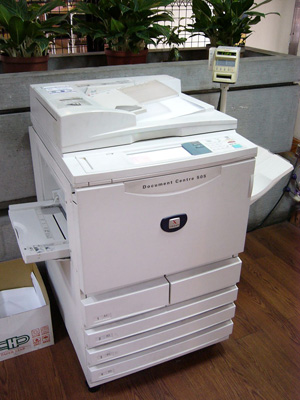Photocopier - Photocopying

A photocopier (also known as a copier or copy machine) is a machine that makes paper copies of documents and other visual images quickly and cheaply. Most current photocopiers use a technology called xerography, a dry process that uses electrostatic charges on a light-sensitive photoreceptor to first attract and then transfer toner particles (a powder) onto paper in the form of an image. Heat, pressure or a combination of both is then used to fuse the toner onto the paper. (Copiers can also use other technologies such as ink jet, but xerography is standard for office copying.)
Xerographic office photocopying was introduced by Xerox in 1959, and it gradually replaced copies made by Verifax, Photostat, carbon paper, mimeograph machines, and other duplicating machines.
Photocopying is widely used in the business, education, and government sectors. While there have been predictions that photocopiers will eventually become obsolete as information workers increase their use of digital document creation, storage and distribution, and rely less on distributing actual pieces of paper, as of 2015, photocopiers continue to be widely used. In the 2010s, there is a convergence in some high-end machines between the roles of a photocopier, a fax machine, a scanner, and a computer network-connected printer. As of 2015, some high-end machines can copy and print in color.
History
Chester Carlson, the inventor of photocopying, was originally a patent attorney, as well as a part-time researcher and inventor. His job at the patent office in New York required him to make a large number of copies of important papers. Carlson, who was arthritic, found this to be a painful and tedious process. This motivated him to conduct experiments with photoconductivity. Carlson used his kitchen for his "electrophotography" experiments, and, in 1938, he applied for a patent for the process. He made the first photocopy using a zinc plate covered with sulfur. The words "10-22-38 Astoria" were written on a microscope slide, which was placed on top of more sulfur and under a bright light. After the slide was removed, a mirror image of the words remained. Carlson tried to sell his invention to some companies, but failed because the process was still underdeveloped. At the time, multiple copies were most commonly made at the point of document origination, using carbon paper or manual duplicating machines, and people did not see the need for an electronic machine. Between 1939 and 1944, Carlson was turned down by over 20 companies, including IBM and General Electric—neither of which believed there was a significant market for copiers.
In 1944, the Battelle Memorial Institute, a non-profit organization in Columbus, Ohio, contracted with Carlson to refine his new process. Over the next five years, the institute conducted experiments to improve the process of electrophotography. In 1947, Haloid Corporation (a small New York-based manufacturer and seller of photographic paper) approached Battelle to obtain a license to develop and market a copying machine based on this technology.
Haloid felt that the word "electrophotography" was too complicated and did not have good recall value. After consulting a professor of classical language at Ohio State University, Haloid and Carlson changed the name of the process to "xerography," which was derived from Greek words that meant "dry writing." Haloid called the new copier machines "Xerox Machines" and, in 1948, the word "Xerox" was trademarked. Haloid eventually changed its name to Xerox Corporation.
In 1949, Xerox Corporation introduced the first xerographic copier called the Model A. Xerox became so successful that, in North America, photocopying came to be popularly known as "xeroxing." Xerox has actively fought to prevent "Xerox" from becoming a genericized trademark. While the word "Xerox" has appeared in some dictionaries as a synonym for photocopying, Xerox Corporation typically requests that such entries be modified, and that people not use the term "Xerox" in this way. Some languages include hybrid terms, such as the widely used Polish term kserokopia ("xerocopy"), even though relatively few photocopiers are of the Xerox brand.
